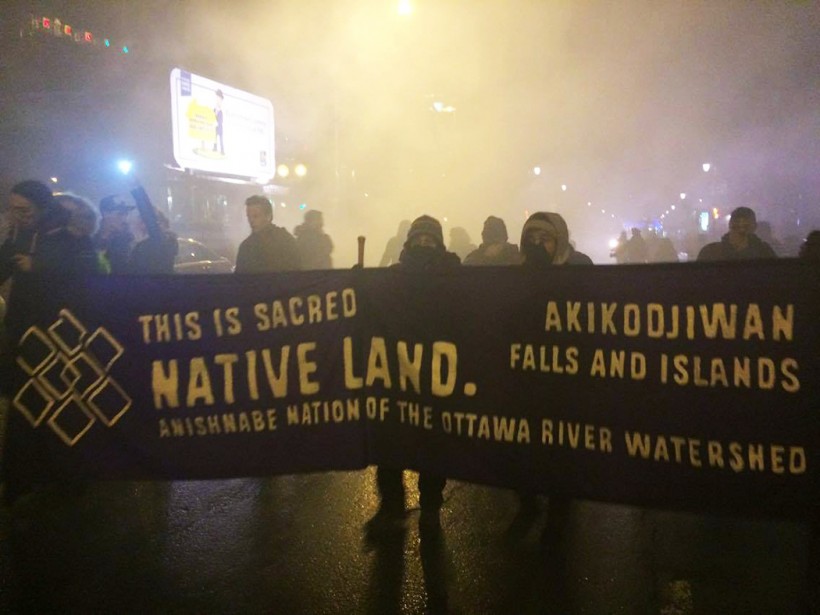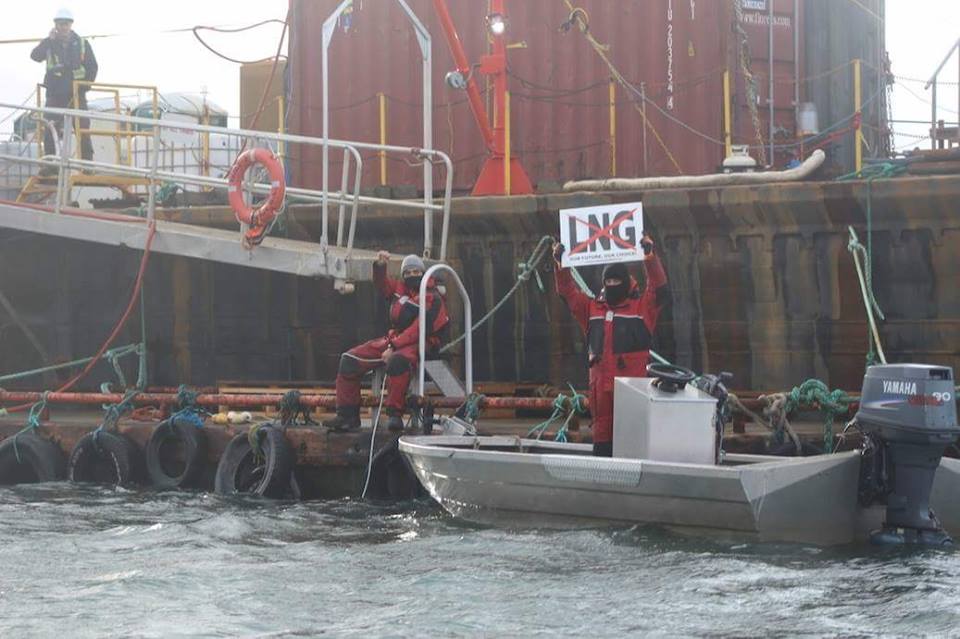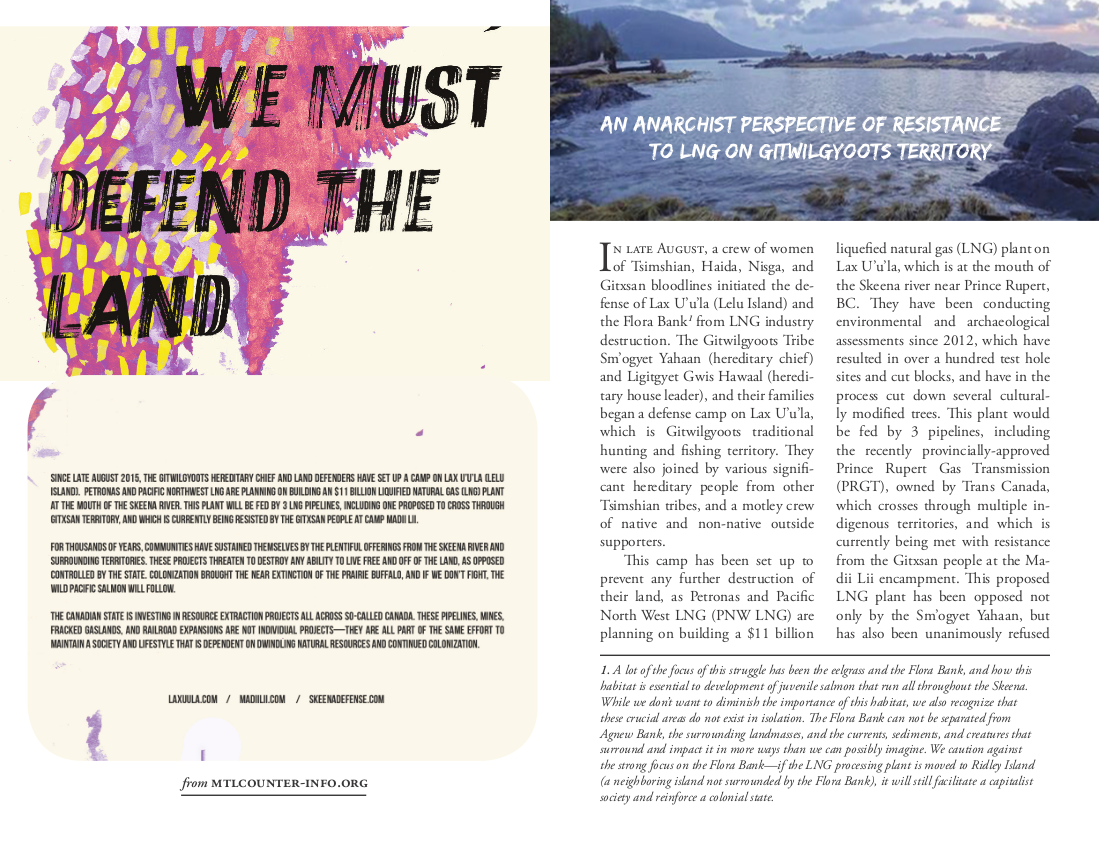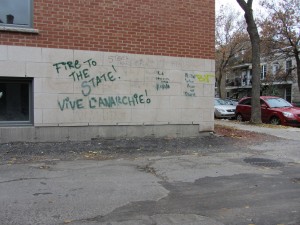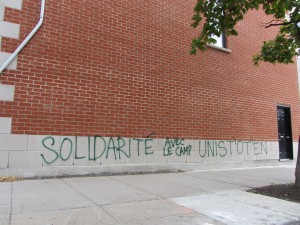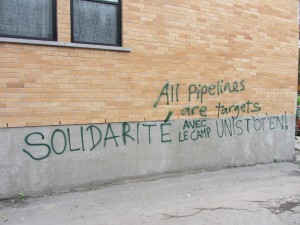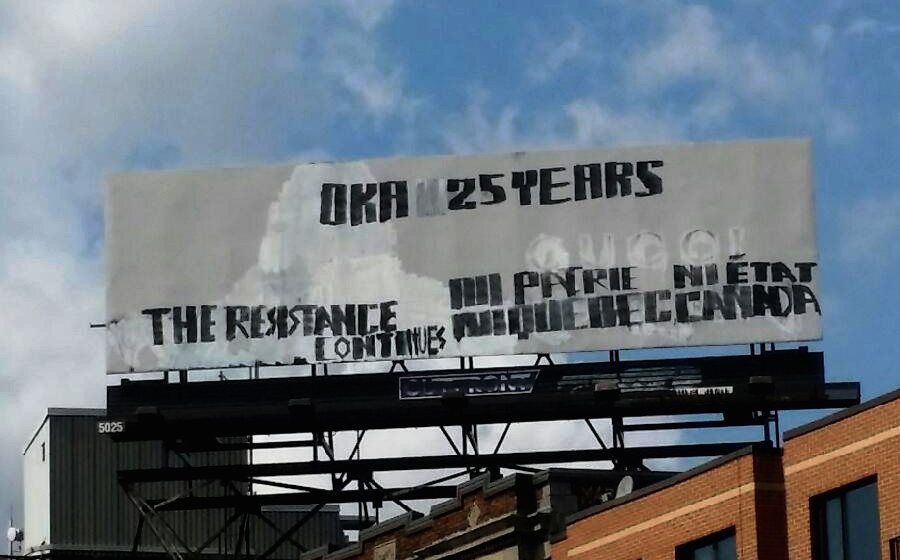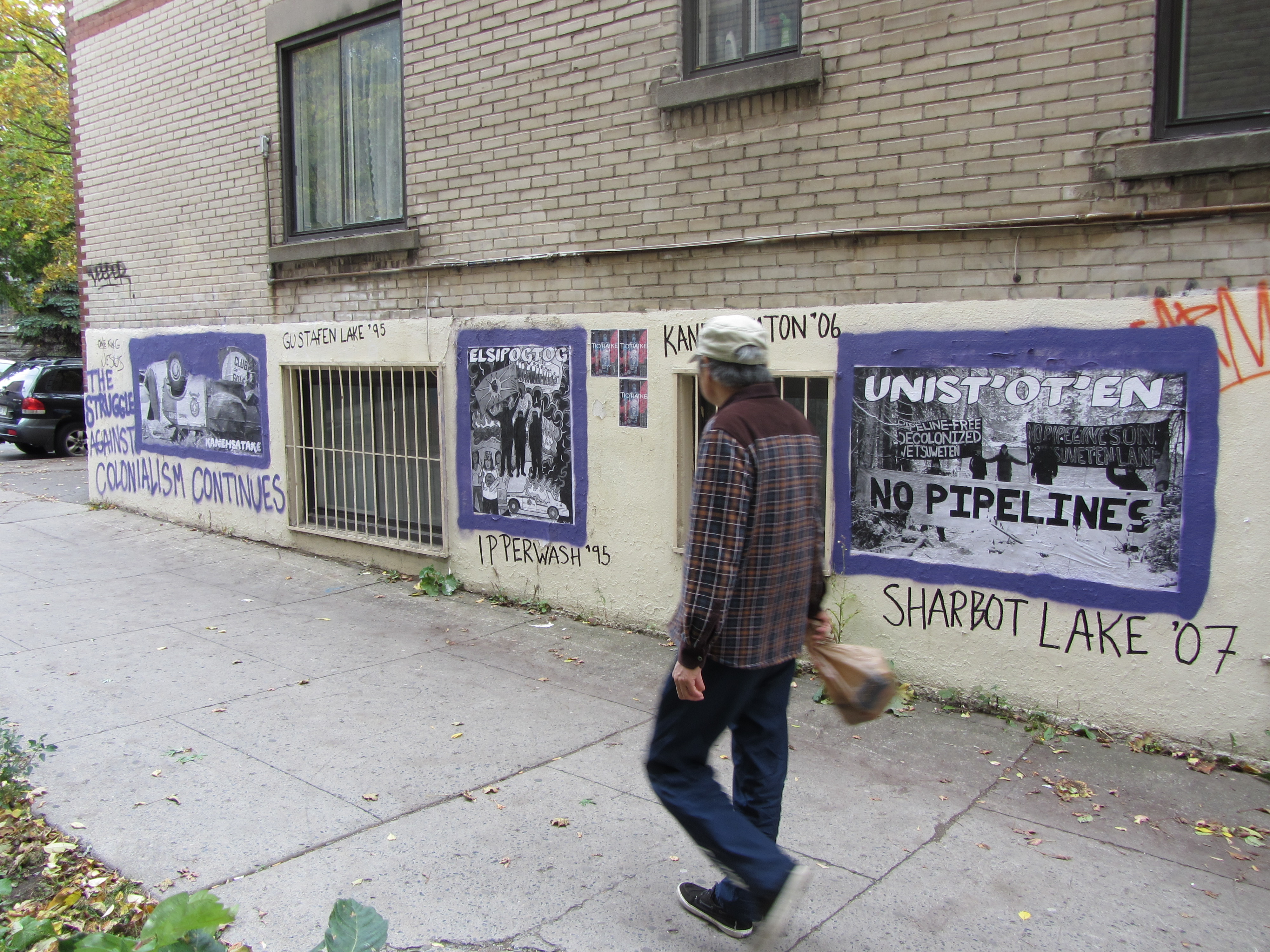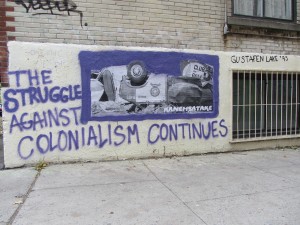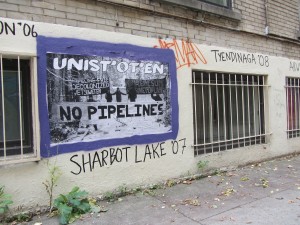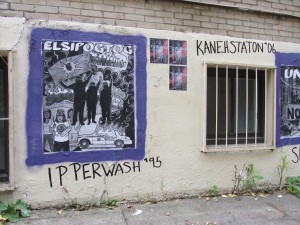From Fire to the Prisons
The following is an interview with Gord Hill (Kwakwaka’wakw nation), who frequently writes under the pseudonym Zig Zag. He is also the author of The 500 Years of Resistance Comic Book, The Anti-Capitalist Resistance Comic Book (both published by Arsenal Pulp Press), and 500 Years of Indigenous Resistance (published by PM Press).
Fire to the Prisons (FttP): In 2014 there has been a flurry of activity in Native communities who are engaged in blockades of roads against timber sales, mining projects, against missing and murdered aboriginal women, occupations of hydro dams, against trophy hunting, and also large blockades against oil pipelines. Can you tell us more about these campaigns and actions and the context in which they are happening? What drives these struggles?
Zig Zag (ZZ): Native peoples in Canada have been carrying out blockades and other actions since the 1970s, in the modern era as it were. In the last few years, beginning perhaps in the early 2000s, there has been an increase in these activities of protest and resistance for various reasons; I don’t think there’s one particular reason. Each campaign or struggle has its own history and characteristics; events that make them grow or decline. Having said that I would also add that there seems to be an overall increase in political consciousness and activity over the last decade, and I think this is occurring on a global level so that when Native peoples in Canada see events such as the “Arab Spring” or Occupy, or the Toronto G20 [riots], there’s a sense that protesting is something that’s more “acceptable” or common, or perhaps even productive. But as I mentioned, each struggle also has its own dynamics that drive it.
In regards to the missing and murdered women, this has been a campaign that began in the late 1990s and in particular the high number of women that began disappearing from Vancouver’s Downtown Eastside, when there were somewhere around 70 missing women dating back to the 1970s, and mostly through the ‘80s and ‘90s. By the late ‘90s, Native women’s groups in Vancouver began organizing, including an annual memorial march on February 14th. Since that time, other towns and cities have also begun organizing similar rallies and marches to draw attention to this issue. So that’s how this campaign has increased, and more recently, over the last two years, some communities have also carried out temporary blockades of highways and trains.
The anti-pipeline struggle is another example of a campaign that has emerged over the last few years, as a result of increased Tar Sands production and Canada’s goal of becoming a major petro-state for the Asian and US markets. All this requires pipelines to transport the oil and gas, originally envisioned as passing through central British Columbia (BC) from Alberta, to coastal ports and then on tanker ships. These proposals for several major pipelines have given rise to an unprecedented mobilization of Natives in central BC and along the coast in opposition to both major pipeline projects and oil tanker traffic. Even government-imposed band councils have voiced their opposition to some of these (while making agreements for others). And this anti-pipeline, anti-oil tanker movement is informed by various factors, including the Exxon Valdez oil spill in southern Alaska and northern BC that resulted in extensive environmental damages that persist to this day, the 2005 sinking of the Queen of the North ferry in an area similar to the route proposed for oil tanker traffic, the 2011 Gulf of Mexico BP oil spill which horrified people around the world and across BC, as well as ongoing and frequent reports of new oil pipeline ruptures and tanker spills.
Protests and blockades against logging have been somewhat common since at least the 1970s, and in fact occur less frequently now due to a decline in the forestry industry overall, although some communities such as Grassy Narrows in Ontario are still fighting to stop clear cut logging.
In regards to mining projects, some of the more recently proposed mining projects have been in central and northern BC, areas which have only been opened up to large scale exploration and industrial activity since the 1970s and ‘80s. Some new mining projects, as well as oil and gas development, is the result of new technologies that make it economically worthwhile to build roads and other infrastructure, so in these areas as well Native peoples are mobilizing to defend vital parts of their territories, such as the Tahltan in north BC who have resisted various mining and gas projects for the last 7-8 years. More recently, there was a major disaster in BC at the Mount Polley mine, when its tailings pond ruptured sending large amounts of contaminated water into a river and forest system. Operated by Imperial Metals, Mt. Polley is located in Secwepemc territory, who are already opposing other mining projects. Now, other communities facing similar mining projects, including those operated by Imperial Metals, are more determined to stop new mining projects.
Overall, you can see an increase in industrial development in more northern regions across Canada, as well as an increase in Indigenous resistance against these projects. I also wouldn’t discount the effect of social media and people being able to not only gain counter-information, but also the ability to produce their own communications when, for example, a small isolated community carries out a blockade. In the 1980s, it would’ve taken longer for information to get out unless the corporate media was covering it.
FttP: There is a long history of indigenous resistance in what is called Canada dating back to European invasion. In the last several decades, there has been large scale armed defense of land occupations. Can you tell us about this history and how it informs current struggles?
ZZ: The first Native armed actions in Canada occurred in 1974, following the siege at Wounded Knee in 1973. These were at Cache Creek, BC, and Anicinabe Park in Ontario. Without doubt, the most significant armed standoff occurred in 1990 involving the Mohawk communities of Kanesatake and Kahnawake, both of which are near Montreal, Quebec. This standoff emerged over a conflict about the municipality of Oka’s decision to expand a nine hole golf course and to build a condominium project into an area known as the Pines, which contained a Mohawk graveyard, lacrosse field, as well as the last patch of trees left in the area. Many non-Native Oka residents also opposed these projects. Over the course of about a year the Mohawks and citizens organized protests and petitions, and in the spring of 1990 began blockading a small dirt road. On July 11, the Surete du Quebec (Quebec provincial police) attempted to raid the blockade and dismantle it, but their heavily armed tactical unit was met with armed resistance by warriors. After a brief fire fight one cop was killed, and the rest of the police retreated, abandoning their vehicles which were then used to expand the blockade to include nearby highways and roads. At the same time Mohawks in Kahnawake blockaded the Mercier Bridge, a major commuter link from the suburbs to downtown Montreal. This set in motion a 77 day armed standoff. By August, the Canadian military deployed a mechanized brigade of about 5,000 soldiers.
The standoff at Oka generated widespread solidarity across the country, with Natives occupying government buildings and blockading highways and trains. Some sabotage also occurred, with railway bridges and electrical transmission towers brought down. The golf course was never expanded, and the condos were never built. Oka had a tremendous effect on Indigenous struggles in Canada and set the tone for resistance actions through the decade and to this day. The imagery of masked and camouflaged warriors has been emulated across the country at numerous protests and blockades, without the AK-47s.
In 1995 there was another armed standoff in south central BC at a place called Gustafsen Lake located in Secwepemc territory, who called the lake Ts’Peten. This standoff occurred after a US rancher sought to evict a Sundance camp which was located on Crown land. After his cowboys had threatened an elder and his family, warriors traveled to the camp to offer protection, and the New Democratic Party, a social democratic party then in power as the provincial government, authorized a major police operation involving over 450 heavily armed police from the RCMP. They acquired armored personnel vehicles from the Canadian military, flew surveillance planes over the camp, and on September 11th ambushed a vehicle used by the defenders by detonating an explosive charge which blew up the front end of the truck and then rammed it with an APC. This initiated an hours long fire fight, during which police fired over 77,000 rounds of ammunition, killing a dog and wounding one defender. This standoff lasted about a month, and ended after the defenders laid down their arms. One elder, Wolverine, received the longest jail sentence of 8 years.
While these acts of armed resistance are historical events which had profound impacts on Indigenous people’s struggles in Canada, they are not very common. While the Mohawks have both the resources and personnel with military experience to engage in these types of actions, most communities do not. Most communities are more capable of carrying out low-level acts of resistance, including blockades, which are far more common than armed actions. I think the recent example of the Mi’kmaq anti-fracking struggle in New Brunswick is a good example of this, and one that more communities could engage in. Another recent example would be the resistance at Six Nations, where hundreds of people from the community engaged in blockades as well as acts of sabotage to stop the construction of a condo project.
FttP: In a recent interview with the Canadian anarchist Franklin Lopez, they talked about how the success of road blockades has driven many people to continue and expand the tactic. Can you attest to this success?
ZZ: Indigenous peoples in Canada have been using the blockade tactic since the 1970s, and in the ‘80s the governmentfunded band councils also began using blockades during negotiations with government or industry as political leverage/ public relations types of activities. But certainly many grassroots movements continue to use the blockade because they are effective in disrupting industrial activity and creating political pressure on the state. In addition, many highways, roads, and railways are located near reserves or cut right through reserves, so they are easily accessible.
FttP: In an interview you did regarding the Idle No More movement, you talk about the class dynamics of the leadership structure and the limit of reformist aims. Can you tell us more?
ZZ: The official organizers of INM came from middleclass professions: lawyers and academics, so this class position determined their overall methods which were entirely focused on legal-political reforms. They worked closely with another middle-class element which were Indian Act band councilors and chiefs. They came out strongly against any radical actions such as blockades and attempted to impose control over the movement, in particular their pacifist beliefs. In fact, it was the first time a major mobilization like this imposed pacifist methods on Native peoples. The main goal of this movement was to stop the federal government from passing an omnibus budget bill that was going to change many federal laws, including ones providing some level of environmental protection for land and water. The bill passed in mid-December, however, and despite a few more weeks of large rallies the movement was unable to sustain itself.
One aspect of their legalistic-pacifist approach was a strict limit on the types of actions people could carry out, so they were really limited to “flash mob” round dances in shopping malls and city streets, which ultimately have little impact. Thankfully this movement, while it did indeed mobilize thousands of Natives out to rallies, did not last long. We can compare the tactics of INM to those used during the Quebec student strike of 2012, which included not only ongoing rallies but also occupations and militant street protests that cost the Quebec government millions of dollars in property damage and lost revenue. The strike led to the cancellation of the student tuition increase as well as a change in the provincial government. Or you can look at the Six Nations land reclamation, which cost the state tens of millions of dollars in property damage, compensation, paying for policing operations, and lost business. That condo project has never been built.
FttP: In a recent talk you did on anarchism and indigenous resistance, you discuss ways in which the two struggles work together and support each other. Can you tell us more?
ZZ: Well I think I mostly talked about the similarities between anarchist and Indigenous struggles and how there were more possibilities for solidarity as a result of this, and in particular the general absence of a centralized State system, the emphasis on decentralized and autonomous forms of self-organization, and the need for anti-colonial and anti-capitalist analysis in both movements. This can be compared to other forms of organization used by groups such as political parties or unions, as well as NGOs, all of which typically have bureaucratic or even hierarchical structures.
These types of groups often align themselves with the Indian Act band councils, which are often in conflict with genuine grassroots movements.
FttP: In the same talk, you relate the black bloc to Warrior Societies. How do you think anarchists could popularize more confrontational tactics to be seen in a more positive light, and not as ‘outside agitators’ or people who bring upon repression to social struggles?
ZZ: I think one of the big problems the Left or “progressive movements” have in North America is a real lack of fighting spirit or combativeness. They are so controlled and dominated by professional organizers who pursue strictly legal-political forms of struggle; that people who want to engage in more radical and militant actions are marginalized and isolated, which makes them vulnerable to State repression. Every successful resistance movement in history has used a diversity of tactics, including militant actions. When a movement wants to raise the level of militancy I think one of the most important steps is to build a culture of resistance, and to begin to “normalize” acts of resistance. At the same time, movements also have to go through learning phases. A lot of people who get involved at first think purely in terms of legal-political reforms, petitions to State officials, peaceful rallies, etc. This is “normalized” by the bureaucrats who run most of the social justice, NGO-type groups, as well as corporate media and entertainment. Only by participating in struggles and learning first-hand the futility of using strictly legal-political means will people become radicalized and begin using more militant tactics.
FttP: In one of your latest publications, “Smash Pacifism: A Critical Analysis of Gandhi and King,” you argue that in the US, pacifist movements are largely headed by middle-class leadership. You also argue that riots had a much larger effect on policy changes than non-violent pleas for reform. Can you tell us more?
ZZ: Well the “official” leadership of the Black civil rights movement were certainly middle class, they were Baptist preachers, lawyers, and other professionals who, because of their greater resources and “legitimacy,” were able to exert significant influence and control over the movement, as occurs in virtually every social movement in North America. In regards to the riots, the official history of the civil rights movements showcases the peaceful rallies and arrests as being what made significant change, when in reality it was a diversity of tactics including armed resistance as well as mass urban revolts, which inflicted hundreds of millions of dollars in damages to property. It was this economic disruption, and the threat of even greater unrest, that prompted the federal government to enact civil rights legislation and to also begin dumping millions and millions of dollars into poor communities and organizations as part of the “war on poverty,” which led to the institutionalization of the non-governmental organization industry. But I don’t think it’s as simple as saying the riots did more than the civil rights protests, because they all contributed to overall rebelliousness of the Black population. Some of the main proponents of militant Black Power came out of the “nonviolent” groups, such as Stokely Carmichael, for example.
FttP: As we speak, from droughts to diseases and disasters brought on by climate change, things continue to get worse as capitalist civilization pushes us closer to the brink. Some small towns are without water, and fracking pollutes watersheds and threatens people’s lives. What advice would you give militants and radicals working within this context?
ZZ: Along with anti-capitalist and anti-colonial analyses I also advocate a dual strategy of survival and resistance. Resistance is necessary to defend land and people to ensure our survival into the future, while at the same time we must consider the overall situation and the increasing possibility of substantial systemic failures arising from various intertwining sources, including economic and ecological crises. If we were to simply focus on survival we would prepare, learn skills, secure land, etc, but vast areas of land could be contaminated in the meantime that would severely erode people’s ability to survive in the long term. I think that by organizing a broader resistance we can also build stronger networks that will also assist in long term survival.
FttP: Throughout your art work and writings, you often discuss how drugs and alcohol are used against Native peoples and aid in their subjugation. From trailer parks where meth is produced to ghettos filled with CIA funded crack-cocaine, we see similar realities elsewhere. Do you have any advice to others working for radical change in these situations?
ZZ: The subject of drug and alcohol addiction is something I touch on, but I wouldn’t describe it as “often.” It’s a social reality that oppressed populations suffer from higher levels of social dysfunction, with drugs and alcohol being common. From my experience in working with communities it’s best to not take a judgmental attitude or you’ll just alienate large sectors of the population. You have to know people’s strengths and weaknesses, and if they have drug and/or alcohol addictions then that needs to be considered when planning actions or campaigns, knowing that some people will not be reliable for some types of work, or can’t be trusted with handling money, etc. But these people can change, and I know when communities are actually engaged in resistance and large numbers of people participate, the levels of drug and alcohol abuse decline because people are working together, feeling solidarity and purpose for a common good.
FttP: What can people expect from you in the future? What projects are you working on that you are excited about?
ZZ: I am presently maintaining the site:
WarriorPublications.wordpress.com where I post news relating to Indigenous people’s struggles, primarily in Canada.




